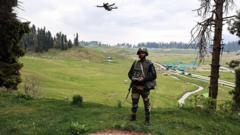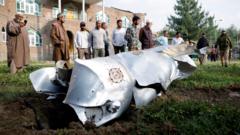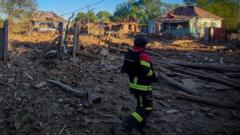The military conflict between India and Pakistan has rapidly escalated, marking one of the most intense periods of hostility in decades. The situation arose from an attack that left 26 civilians dead in Kashmir, prompting both nations to engage in military strikes that have claimed civilian lives and generated widespread fear. Diplomatic efforts to de-escalate the tensions continue, but the trajectory of the conflict remains uncertain.
Escalation in India-Pakistan Conflict: A New Era of Warfare and Diplomacy

Escalation in India-Pakistan Conflict: A New Era of Warfare and Diplomacy
A series of military confrontations between India and Pakistan over Kashmir has intensified, leading to widespread casualties and fears of broader conflict.
The escalating conflict along the India-Pakistan border has reached unprecedented levels, with both nations exchanging military strikes and accusations. Reports indicate that both governments are targeting locations beyond the traditional Kashmir conflict zone, leading to a significant rise in civilian casualties.
The hostilities intensified following a tragic incident on April 22 in Kashmir, where armed militants killed 26 tourists, nearly all identified as Hindus. This prompted India to launch a military operation, leading to retaliatory strikes from Pakistan that have included shelling and drone attacks.
The Indian Army claims to have thwarted drone incursions along its western front—the entirety of the India-Pakistan border—although Pakistan has disputes these claims. Both sides accuse each other of innocent civilian casualties, further complicating the situation.
The use of advanced warfare technologies, particularly drones, has altered the landscape of this historic rivalry, amplifying both the danger and the complexity of the military engagements. The chaotic information environment—enhanced by the prevalence of misinformation and the use of social media—has led to heightened tensions among the civilian populations, with many residents fearing for their safety and survival.
In response to the conflict, residents in regions adjacent to the border have begun stockpiling supplies, reflecting a palpable sense of anxiety across India. Schools have been closed in both countries in anticipation of further escalation. The disruption has not only affected those living near the borders but has also impacted air travel, as flights were diverted from affected airspaces.
Diplomatic channels have been activated, with high-level discussions among regional leaders, including those from Saudi Arabia and Qatar, aimed at reducing tensions. U.S. officials have also engaged in dialogues with the leaders of both countries to push for an immediate ceasefire.
Despite these efforts, analysts caution that the situation may spiral further out of control. Long-standing hostilities over Kashmir—a region claimed by both nations—continue to serve as a flashpoint, and the public's reaction to governmental actions raises concerns about potential retaliatory or escalatory measures.
This current conflict illustrates the precarious nature of South Asian geopolitics, where historical grievances, current militancy, and international diplomacy could converge to create a significant crisis. The ongoing situation serves as a reminder of the fragile peace between two nuclear neighbors and the urgent need for effective conflict resolution strategies to prevent further deterioration.
The hostilities intensified following a tragic incident on April 22 in Kashmir, where armed militants killed 26 tourists, nearly all identified as Hindus. This prompted India to launch a military operation, leading to retaliatory strikes from Pakistan that have included shelling and drone attacks.
The Indian Army claims to have thwarted drone incursions along its western front—the entirety of the India-Pakistan border—although Pakistan has disputes these claims. Both sides accuse each other of innocent civilian casualties, further complicating the situation.
The use of advanced warfare technologies, particularly drones, has altered the landscape of this historic rivalry, amplifying both the danger and the complexity of the military engagements. The chaotic information environment—enhanced by the prevalence of misinformation and the use of social media—has led to heightened tensions among the civilian populations, with many residents fearing for their safety and survival.
In response to the conflict, residents in regions adjacent to the border have begun stockpiling supplies, reflecting a palpable sense of anxiety across India. Schools have been closed in both countries in anticipation of further escalation. The disruption has not only affected those living near the borders but has also impacted air travel, as flights were diverted from affected airspaces.
Diplomatic channels have been activated, with high-level discussions among regional leaders, including those from Saudi Arabia and Qatar, aimed at reducing tensions. U.S. officials have also engaged in dialogues with the leaders of both countries to push for an immediate ceasefire.
Despite these efforts, analysts caution that the situation may spiral further out of control. Long-standing hostilities over Kashmir—a region claimed by both nations—continue to serve as a flashpoint, and the public's reaction to governmental actions raises concerns about potential retaliatory or escalatory measures.
This current conflict illustrates the precarious nature of South Asian geopolitics, where historical grievances, current militancy, and international diplomacy could converge to create a significant crisis. The ongoing situation serves as a reminder of the fragile peace between two nuclear neighbors and the urgent need for effective conflict resolution strategies to prevent further deterioration.

















